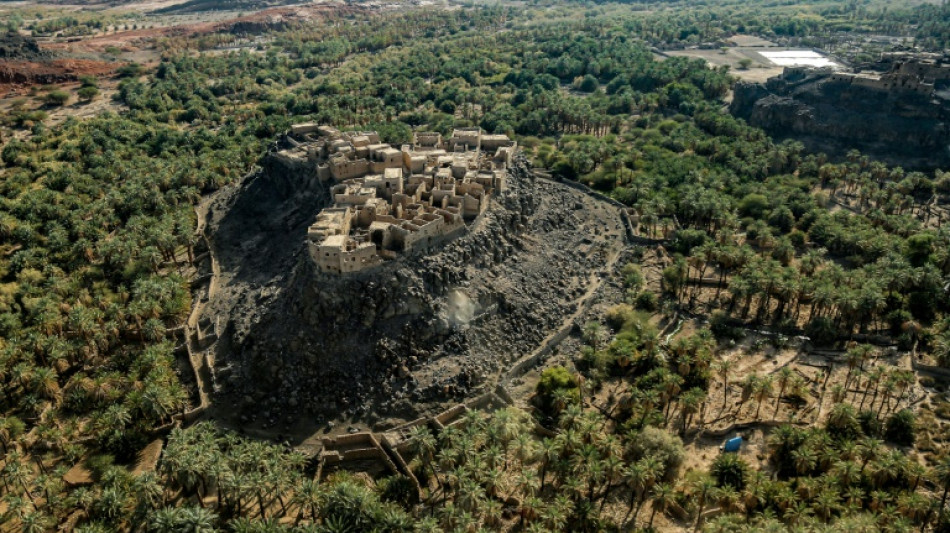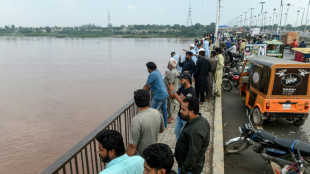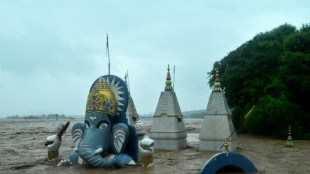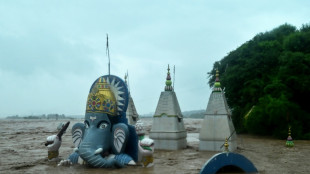
-
 Denmark apologises for Greenland forced contraception
Denmark apologises for Greenland forced contraception
-
Hungary web users lap up footage of PM Orban's family estate

-
 Alexander Isak selected by Sweden despite Newcastle standoff
Alexander Isak selected by Sweden despite Newcastle standoff
-
Italy's Sorrentino embraces doubt in euthanasia film at Venice

-
 Trump urges criminal charges against George Soros, son
Trump urges criminal charges against George Soros, son
-
Wildfires pile pressure on Spanish PM

-
 Stock markets mixed ahead of Nvidia earnings
Stock markets mixed ahead of Nvidia earnings
-
Football's loss as hurdles sensation Tinch eyes Tokyo worlds

-
 Pakistan blows up dam embankment as it braces for flood surge
Pakistan blows up dam embankment as it braces for flood surge
-
Lego posts record sales, sees market share growing further: CEO

-
 France overlook Ekitike for World Cup qualifiers, Akliouche called up
France overlook Ekitike for World Cup qualifiers, Akliouche called up
-
Rain no obstacle, Lyles insists ahead of Diamond League finals

-
 Record-breaking rain fuels deadly floods in India's Jammu region
Record-breaking rain fuels deadly floods in India's Jammu region
-
Showtime for Venice Film Festival where stars and Gaza protesters gather

-
 Almodovar urges Spain cut ties with Israel over Gaza
Almodovar urges Spain cut ties with Israel over Gaza
-
Macron gives 'full support' to embattled PM as crisis looms in France

-
 Stock markets diverge awaiting Nvidia earnings
Stock markets diverge awaiting Nvidia earnings
-
German cabinet agrees steps to boost army recruitment

-
 Denmark summons US diplomat over Greenland 'interference'
Denmark summons US diplomat over Greenland 'interference'
-
German factory outfitters warn of 'crisis' from US tariffs

-
 Israel ups pressure on Gaza City as Trump eyes post-war plan
Israel ups pressure on Gaza City as Trump eyes post-war plan
-
Floods, landslides kill at least 30 in India's Jammu region

-
 Former player comes out as bisexual in Australian Rules first
Former player comes out as bisexual in Australian Rules first
-
Indian spin great Ashwin calls time on IPL career

-
 India faces world football ban for second time in three years
India faces world football ban for second time in three years
-
Globetrotter Herzog to get special Venice award

-
 'Old things work': Argentines giving new life to e-waste
'Old things work': Argentines giving new life to e-waste
-
Showtime for Venice Film Festival, with monsters, aliens, Clooney and Roberts

-
 Thai woman jailed for 43 years for lese-majeste freed
Thai woman jailed for 43 years for lese-majeste freed
-
What is swatting? Shooting hoaxes target campuses across US

-
 Row over Bosnia's Jewish treasure raising funds for Gaza
Row over Bosnia's Jewish treasure raising funds for Gaza
-
Police search Australian bush for gunman after two officers killed

-
 NZ rugby player who suffered multiple concussions dies aged 39
NZ rugby player who suffered multiple concussions dies aged 39
-
Former Australian Rules player comes out as bisexual in first

-
 French, German, Polish leaders to visit Moldova in show of force in face of Russia
French, German, Polish leaders to visit Moldova in show of force in face of Russia
-
US tariffs on Indian goods double to 50% over Russian oil purchases

-
 Feudal warlord statue beheaded in Japan
Feudal warlord statue beheaded in Japan
-
Tokyo logs record 10 days of 35C or more

-
 Sinner, Swiatek romp through at US Open as Gauff struggles
Sinner, Swiatek romp through at US Open as Gauff struggles
-
Brazil to face South Korea, Japan in World Cup build-up

-
 Asian markets diverge with eyes on Nvidia earnings
Asian markets diverge with eyes on Nvidia earnings
-
Osaka out to recapture sparkle at US Open

-
 China's rulers push party role before WWII anniversary
China's rulers push party role before WWII anniversary
-
Pakistan's monsoon misery: nature's fury, man's mistake

-
 SpaceX answers critics with successful Starship test flight
SpaceX answers critics with successful Starship test flight
-
Nightlife falls silent as Ecuador's narco gangs take charge

-
 Unnamed skeletons? US museum at center of ethical debate
Unnamed skeletons? US museum at center of ethical debate
-
France returns skull of beheaded king to Madagascar

-
 SpaceX's Starship megarocket launches on latest test flight
SpaceX's Starship megarocket launches on latest test flight
-
Guardian Roofing, Gutters & Insulation Credits Team Culture for 20+ Spot Climb in Roofing Contractor’s 2024 Top 100 Nationwide Companies


4,000-year-old town discovered hidden in Arabian oasis
The discovery of a 4,000-year-old fortified town hidden in an oasis in modern-day Saudi Arabia reveals how life at the time was slowly changing from a nomadic to an urban existence, archaeologists said on Wednesday.
The remains of the town, dubbed al-Natah, were long concealed by the walled oasis of Khaybar, a green and fertile speck surrounded by desert in the northwest of the Arabian Peninsula.
Then an ancient 14.5 kilometre-long wall was discovered at the site, according to research led by French archaeologist Guillaume Charloux published earlier this year.
For a new study published in the journal PLOS One, a French-Saudi team of researchers have provided "proof that these ramparts are organised around a habitat", Charloux told AFP.
The large town, which was home to up to 500 residents, was built around 2,400 BC during the early Bronze Age, the researchers said.
It was abandoned around a thousand years later. "No one knows why," Charloux said.
When al-Natah was built, cities were flourishing in the Levant region along the Mediterranean Sea from present-day Syria to Jordan.
Northwest Arabia at the time was thought to have been barren desert, crossed by pastoral nomads and dotted with burial sites.
That was until 15 years ago, when archaeologists discovered ramparts dating back to the Bronze Age in the oasis of Tayma, to Khaybar's north.
This "first essential discovery" led scientists to look closer at these oases, Charloux said.
- 'Slow urbanism' -
Black volcanic rocks called basalt concealed the walls of al-Natah so well that it "protected the site from illegal excavations", Charloux said.
But observing the site from above revealed potential paths and the foundations of houses, suggesting where the archaeologists needed to dig.
They discovered foundations "strong enough to easily support at least one- or two-storey" homes, Charloux said, emphasising that there was much more work to be done to understand the site.
But their preliminary findings paint a picture of a 2.6-hectare town with around 50 houses perched on a hill, equipped with a wall of its own.
Tombs inside a necropolis there contained metal weapons like axes and daggers as well as stones such as agate, indicating a relatively advanced society for so long ago.
Pieces of pottery "suggest a relatively egalitarian society", the study said. They are "very pretty but very simple ceramics", added Charloux.
The size of the ramparts -- which could reach around five metres (16 feet) high -- suggests that al-Natah was the seat of some kind of powerful local authority.
These discoveries reveal a process of "slow urbanism" during the transition between nomadic and more settled village life, the study said.
For example, fortified oases could have been in contact with each other in an area still largely populated by pastoral nomadic groups. Such exchanges could have even laid the foundations for the "incense route" which saw spices, frankincense and myrrh traded from southern Arabia to the Mediterranean.
Al-Natah was still small compared to cities in Mesopotamia or Egypt during the period.
But in these vast expanses of desert, it appears there was "another path towards urbanisation" than such city-states, one "more modest, much slower, and quite specific to the northwest of Arabia", Charloux said.
P.Costa--AMWN